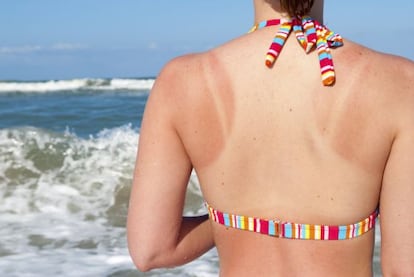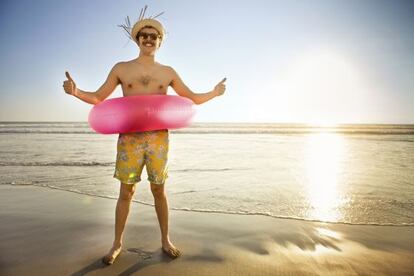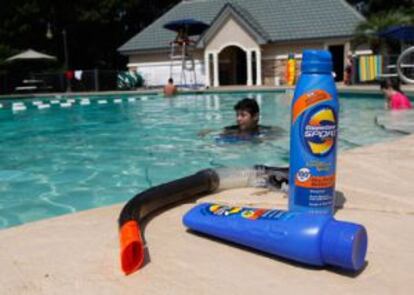Does sun-burnt skin turn brown?
As millions of us head for the beaches, EL PAÍS dispels a few myths about sunbathing

The initials SPF are there for all to see on every single bottle of sunscreen. But 77 percent of Spaniards do not know what that acronym stands for, according to a recent survey by cosmetics company Avène.
SPF means “sun protection factor” and the number after it helps calculate the time we can spend in the sun.
Most sunscreens protect the skin from ultraviolet type B radiation (UVB), the main reason we get sunburnt. But research shows that both ultraviolet type A rays (UVA) and UVB can cause skin cancer and premature ageing of the skin.
When in doubt, says Antonio Licitra, a specialist in cosmetic medicine, just protect yourself “whenever you go out, even on cloudy days.”
Here are some commonly held beliefs about sunscreen that sometimes turn out to be wrong.
1. An SPF 30 cream protects twice as much as an SPF 15: Wrong. There is no sunscreen that will protect you 24 hours a day. “Staying out of the sun is the only way to guarantee 100-percent protection,” says researcher Roopal Kundu. “Each degree of SPF (6, 15, 20, 30, or 50) refers to the amount of time the skin is protected,” says a spokesman for Douglas Sun, the sunscreen division of Avène.
Start with the time your skin takes to burn without protection, and multiply it by the number on the bottle. “For example, if you take 20 minutes to burn and use SPF 15, you will be protected for 300 minutes, or five hours (SPF 15 x 20 minutes = 300 minutes). Somebody with lightly pigmented skin who burns in 10 minutes would only be protected for around two-and-a-half hours (SPF 15 x 10 minutes = 150 minutes) according to the American Skin Association.
Obviously, each person is different: some of us burn within minutes, and others take much longer. And simply sitting out in the sun to see how long it is before you burn isn’t a good idea, either. “It’s best to be careful during the first days you are out in the sun and use high SPFs,” says skin specialist Ricardo Vicario.
2. You’re protected as soon as you put the sunscreen on: Not always. José Vicente Lajo, who runs a private clinic, explains: “If we use a chemical filter it is important to know that these take around 20 minutes before they start protecting us, while if we use a physical filter, which thanks to its density creates a screen that the sun cannot get through, we are protected immediately.” Creams containing zinc oxide have that physical barrier, while chemical filters absorb UVA and UVB rays, says Lajo.

3. If you put on two creams, you double your protection: Wrong. If you apply an SPF 50 cream and then add SPF 30, you’re not going to get SPF 80. And spreading it on thicker doesn’t help, either. The best method is to reapply sunscreen at appropriate times. “To protect oneself more means putting cream on more frequently,” says Elaine Ferreira of the Prima-Derm group.
4. It’s okay to put makeup on top of sunscreen immediately: Wrong. “You need to wait around 10 minutes so that the protection has been absorbed by the skin before applying makeup,” says Ferreira. Otherwise, you’re simply going to remove the sun cream with the makeup. Paloma Cornejo Navarro, head of dermatology at the IML private clinic, recommends using makeup with SPF 50 and color creams with SPF 90. “What’s more, the physical filters in the makeup pigmentation are safe and help prevent melasma. “But it’s important to retouch your makeup every three to four hours,” she adds.
5. If you’re already tanned, you won’t burn: Wrong. Around 30 percent of Spaniards fail to correctly reapply solar protection, according to Avène's research. Leonor Prieto, scientific director of La Roche-Posay Laboratories, warns: “The skin, even when brown, needs protecting, because the SPF doesn’t just defend the outside skin, but also prevents burns, cell alterations, and the possible appearance of freckles, moles, or melanomas.”

6. If you’re pregnant, you’ll get patches: Wrong. Not all pregnant women develop patches of darkened skin, and patches do not appear just because you’re pregnant, although there is a higher likelihood of it if you sunbathe. “Exposure to the sun increases the possibility of melasma during pregnancy,” says Aurora Rodríguez Huergo of the Hedonai beauty center chain. During pregnancy, hormonal changes “activate the melanocytes that can cause patches to appear that are sometimes known as melasma or chloasma,” says Prieto.
Melasmas are blotchy areas of darkened skin that tend to appear on the face. The darker our skin tone, the more likely melasma is to appear, and in many cases it does not disappear after pregnancy. But it can be avoided: “Some studies show that if we apply a high-protection sunblock – SPF 50 and very high UVA protection – we can avoid the appearance of melasmas on the skin 97 percent of the time,” says Prieto.
7. Dietary supplements have the same effect as sunscreen: Wrong. Beta carotene (or provitamin A) provide vitamins that help assimilate the sun’s rays and achieve a faster tan. “But they don’t create the protective film that the skin needs to prevent damage,” says Vicario. What dietary supplements can do is help avoid premature ageing of the skin caused by exposure to the sun. “It is a good idea at this time of year to increase our intake of food containing lycopene and beta carotene, such as tomatoes, watermelon and carrots, which stimulate the production of collagen, helping the skin recover from the effects of the sun,” says Vicario. Dried fruits can also improve sunscreen protection by 25 percent, while seasonal fruits like cherries, peaches, melon or apricots stimulate melanin production, which helps with healthy tanning.

8. Green tea protects the skin naturally: Doubtful. Some studies on animals have shown that the polyphenols in green tea protected the subjects' skin from the harmful effects of UVA radiation. A study published by the US National Institutes of Health said that "the epicatechin derivatives, commonly called polyphenols, present in green tea possess antioxidant, anti-inflammatory and anti-carcinogenic properties."
9. You don’t need protection on cloudy days: Wrong. Clouds can actually increase the amount of radiation, given that the humidity creates a reflection effect, which means that even when we can’t see the sun, we still need to be protected. “On colder days UVA rays (which turn the skin brown) may decrease a little, but UVB (the main reason we burn and develop melanomas) are the same,” says Rodríguez Huergo.
10. Once you’ve gone red, you’ll turn brown: Wrong. This is what we tell ourselves to feel better after burning our skin at the beach. But burns caused by lack of protection affect the surface of the skin, meaning we peel quickly but retain the memory of the burn within our cells.
11. I won’t tan if I use sunscreen: Wrong. “It may look like you’re not tanning, but in reality you are acquiring color gradually without burning your skin, meaning that your tan will last longer,” says Prieto.

12. If it says “water resistant” I don’t have to worry about getting wet: Wrong. “We say a product is water resistant when it retains 70 percent of the protection factor after two 20-minute swims. And water proof means four 20-minute swims,” says Prieto, adding: “If you do a lot of water sports, you need to use the right clothes and reapply the product to exposed areas after long exposure to water.”
13. Babies can be out in the sun if they have sunscreen: Wrong. It is important to take extra care with young children. Infants have not properly developed their defense systems against the sun, making them vulnerable to burning. Dermatologists and pediatricians say children under three should not be directly exposed to the sun. But even indirect exposure has its dangers. “That is why we recommend using hats, tee-shirts and parasols, and from the age of six months, the use of sunscreens for babies,” says Prieto. The WHO and the scientific community say that repeated exposure to the sun in infancy is a risk factor that can lead to skin cancer later in life.
14. Dark skin needs less protection: Wrong. Pale skin will burn before brown skin, but the fact that darker skin doesn’t burn does not mean that the sun is not applying the same ageing processes to it. A recent study by Douglas Sun notes that “UVA and UVB rays penetrate all skins, affecting the cells.” In other words, however dark your skin is, you face the same risks as the palest person.
15. Using sunscreen prevents us from absorbing vitamin D: Wrong. “If we live a normal life, walking between 10 and 15 minutes in the open air, there will always be exposed areas where we will receive ultraviolet radiation that favors the synthesis of the vitamin D we need to absorb calcium, for example,” says Antonio Licitra.
As a rule, it’s a good idea to avoid direct exposure to the sun. In some cases of vitamin D deficiency, a doctor might advise short periods of time in the sun. There are some health conditions when sun exposure can be useful, but a specialist should decide on the hows and whens. “We should never decide these things ourselves, even if we have heard that the sun helps treat acne, psoriasis, eczema, or some allergies,” concludes Prieto.
Tu suscripción se está usando en otro dispositivo
¿Quieres añadir otro usuario a tu suscripción?
Si continúas leyendo en este dispositivo, no se podrá leer en el otro.
FlechaTu suscripción se está usando en otro dispositivo y solo puedes acceder a EL PAÍS desde un dispositivo a la vez.
Si quieres compartir tu cuenta, cambia tu suscripción a la modalidad Premium, así podrás añadir otro usuario. Cada uno accederá con su propia cuenta de email, lo que os permitirá personalizar vuestra experiencia en EL PAÍS.
¿Tienes una suscripción de empresa? Accede aquí para contratar más cuentas.
En el caso de no saber quién está usando tu cuenta, te recomendamos cambiar tu contraseña aquí.
Si decides continuar compartiendo tu cuenta, este mensaje se mostrará en tu dispositivo y en el de la otra persona que está usando tu cuenta de forma indefinida, afectando a tu experiencia de lectura. Puedes consultar aquí los términos y condiciones de la suscripción digital.
Últimas noticias
The complicated life of Francesca Albanese: A rising figure in Italy but barred from every bank by Trump’s sanctions
How Japan is trying to avert ‘digital defeat’
Half of Scotland is in the hands of 420 property owners
Reinhard Genzel, Nobel laureate in physics: ‘One-minute videos will never give you the truth’
Most viewed
- Pablo Escobar’s hippos: A serious environmental problem, 40 years on
- Reinhard Genzel, Nobel laureate in physics: ‘One-minute videos will never give you the truth’
- Why we lost the habit of sleeping in two segments and how that changed our sense of time
- Charles Dubouloz, mountaineering star, retires at 36 with a farewell tour inspired by Walter Bonatti
- The Florida Keys tourist paradise is besieged by immigration agents: ‘We’ve never seen anything like this’








































